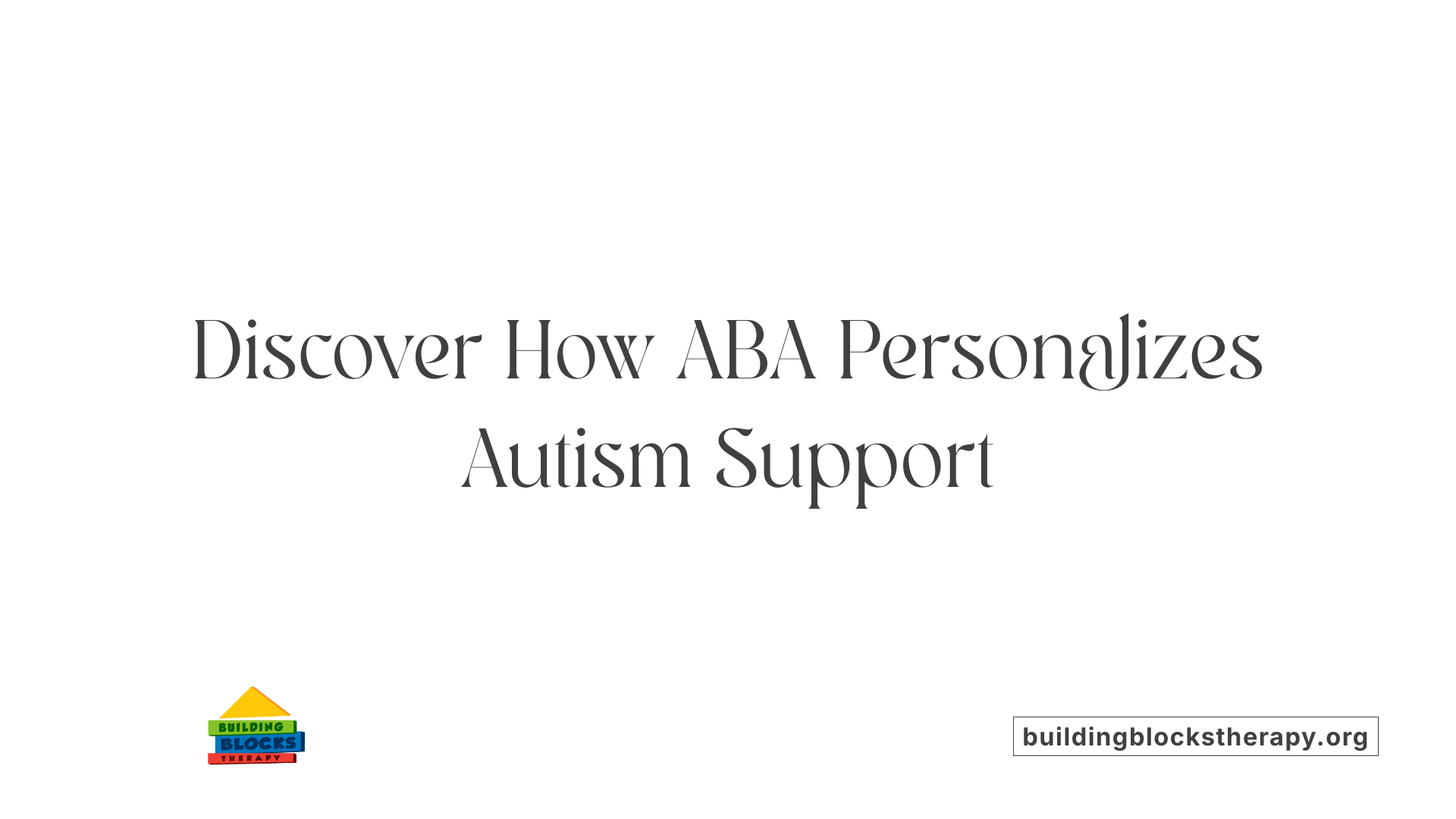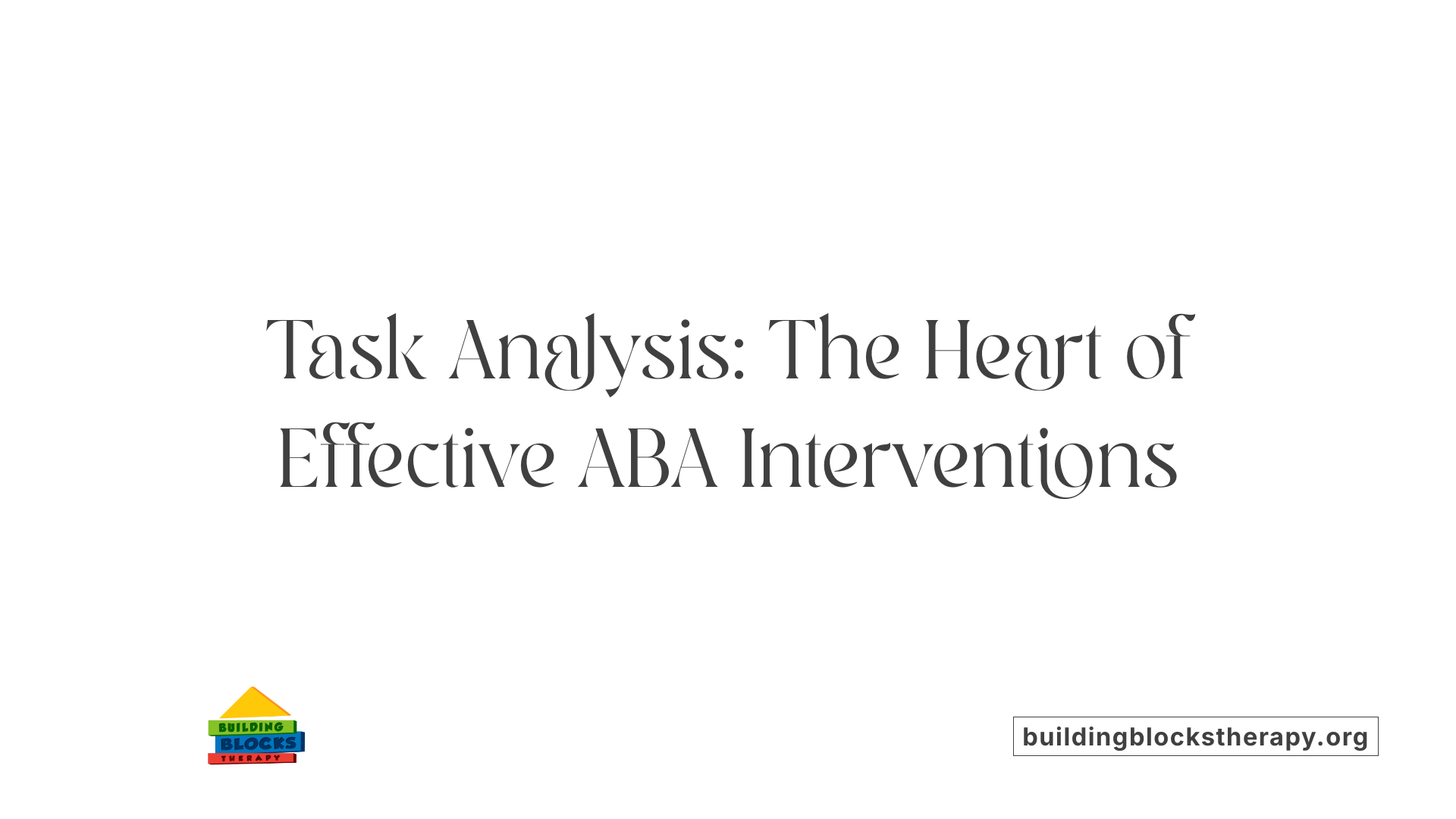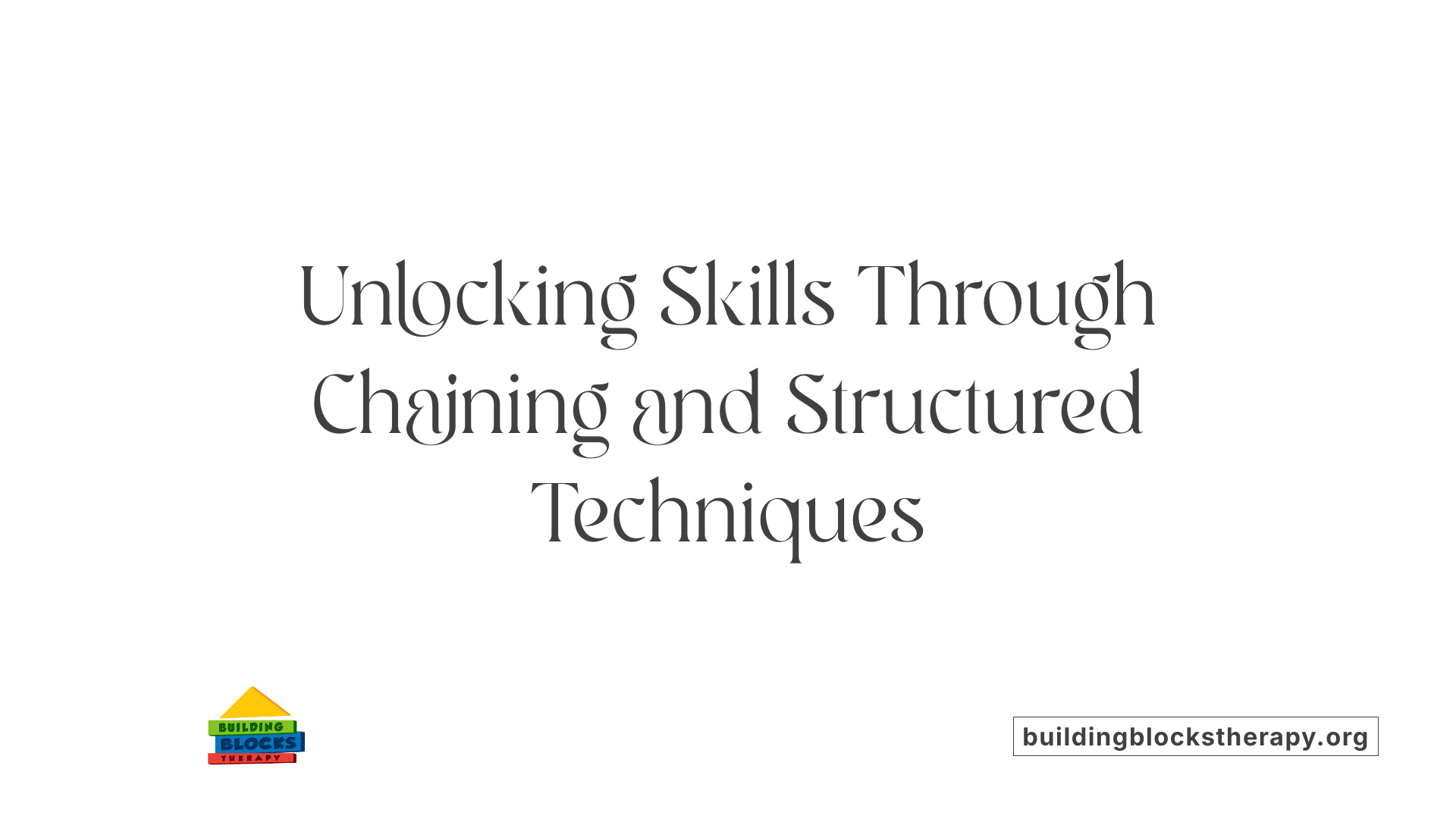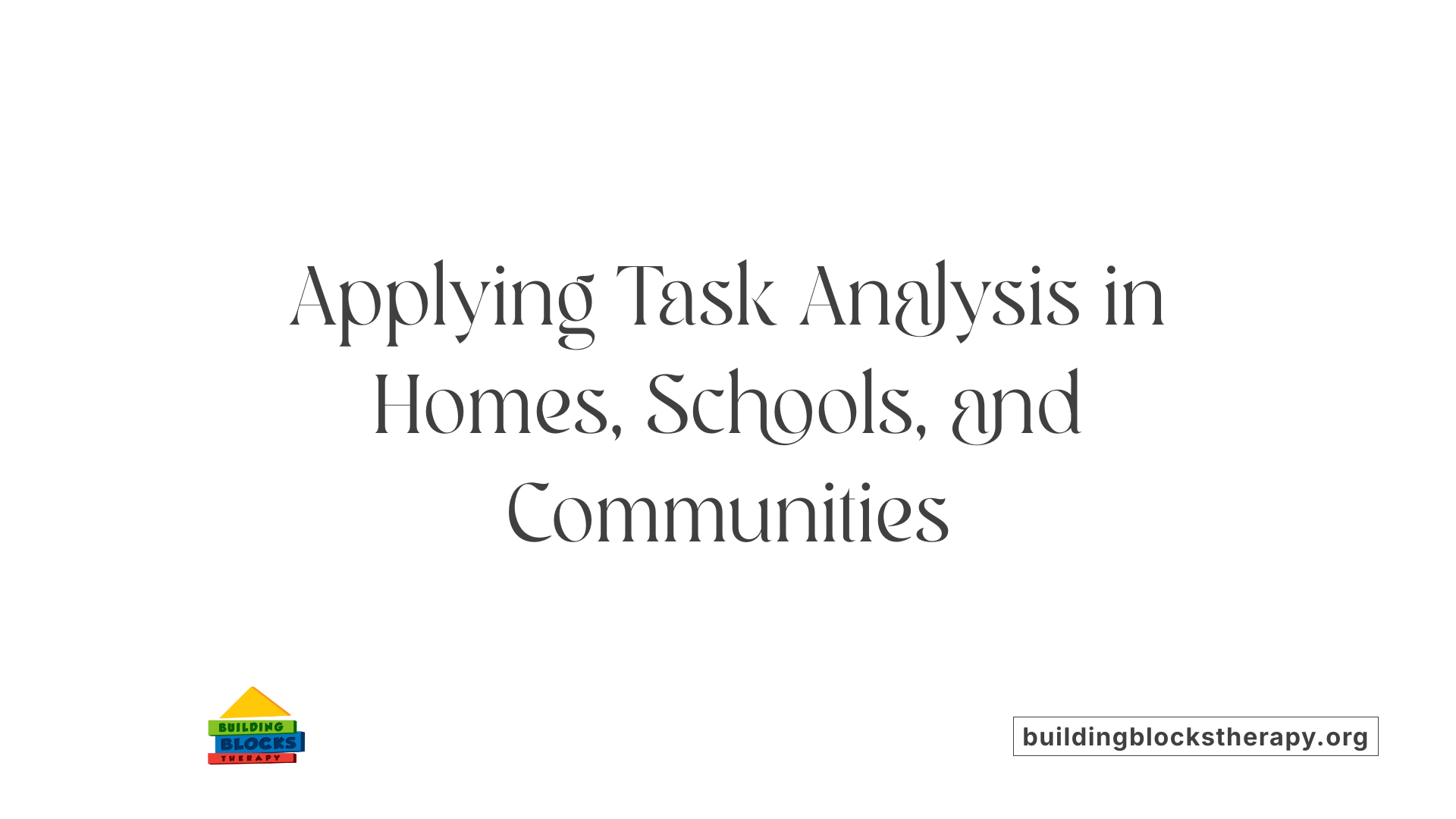The Role of Task Analysis in ABA Therapy for Autism Spectrum Disorder
Breaking Down Barriers: The Power of Task Analysis in Autism Intervention

Understanding the Foundations of ABA and Task Analysis
Applied Behavior Analysis (ABA) therapy stands as a scientifically validated approach for supporting children with autism spectrum disorder (ASD). Among its diverse strategies, task analysis plays a critical role by deconstructing complex skills into teachable, manageable steps tailored to each child's unique needs. This article explores how task analysis functions within ABA therapy, illustrating its methods, benefits, and practical applications to improve independence and quality of life for children with autism.
What Is Behavioral Therapy for Autism?
What is behavioral therapy for autism?
Behavioral therapy for autism primarily revolves around Applied Behavior Analysis (ABA), a scientifically validated method that focuses on modifying behavior by understanding its environmental causes. ABA aims to enhance beneficial behaviors like communication, social interaction, and independence, while reducing harmful or obstructive behaviors.
How does ABA therapy work?
ABA therapy breaks down complex skills into smaller, teachable steps, known as task analysis. This method uses techniques including chaining—forward and backward—discrete trial instruction, and modeling to gradually build new skills.
What are the goals of ABA therapy?
The main objective of ABA is to teach fundamental skills that encourage independence. This may include activities of daily living, such as brushing teeth, washing hands, dressing, and preparing meals. The approach also aims to increase confidence and motivation by allowing children to succeed in smaller steps.
What techniques are used in behavioral therapy?
ABA employs strategies like forward chaining, backward chaining, and total task teaching. Visual supports like picture cards or charts often reinforce each step. Data collection methods such as single-opportunity and multiple-opportunity assessments help track progress and tailor instruction.
Where is ABA therapy delivered?
ABA therapy is adaptable to various environments, including homes, classrooms, and community settings. It can be implemented individually or in groups, ensuring flexible support across the child’s daily life.
How are therapy programs individualized?
Practitioners assess each child’s current skills, temperament, goals, and environment before creating a customized plan. Individualization ensures that instruction is consistent, clear, and appropriate, promoting the generalization of skills across different settings.
Through systematic instruction and individualized planning, behavioral therapy via ABA provides children with autism valuable tools to enhance their independence and improve overall quality of life.
How Does ABA Work in Autism Treatment?

What is the Scientific Basis of ABA?
Applied Behavior Analysis (ABA) is a science-based therapy rooted in behavioral psychology principles. It systematically observes behaviors by analyzing their antecedents and consequences to promote positive changes. The approach relies on personalized behavior interventions designed to increase helpful skills and reduce maladaptive behaviors in individuals with autism spectrum disorder (ASD).
What Techniques Are Used in ABA?
ABA therapy uses various techniques such as positive reinforcement, where desired behaviors are rewarded to encourage repetition. Task analysis breaks down complex skills into manageable steps, making learning simpler for children with ASD. Other methods include chaining (forward and backward), modeling, and discrete trial instruction. Data collection methods like single-opportunity and multiple-opportunity assessments monitor progress, enabling therapists to adjust strategies effectively.
What is the Role of Qualified Professionals?
Qualified behavior analysts (BCBAs) design and oversee ABA interventions, ensuring they are tailored to the individual's skillset, goals, and preferences. They conduct detailed assessments before implementation and modify teaching plans based on ongoing data to maximize outcomes.
What is the Timing and Intensity of ABA Therapy?
Early intervention is critical; ABA typically begins between ages 2 and 6 since younger children benefit more from therapy. Intensive, consistent sessions carried out several hours per week are associated with the best gains in intellectual functioning, language, and social skills.
Which Areas Does ABA Target?
ABA addresses a broad range of developmental areas, including communication, social interaction, daily living skills (such as dressing, brushing teeth, and preparing meals), academic tasks, and even desensitization strategies. For example, task analysis can help children learn activities of daily living by teaching each step sequentially, promoting independence.
What Evidence Supports the Effectiveness of ABA?
Research shows that ABA delivers significant improvements in many domains for children with autism. Benefits include enhanced independence, reduced frustration, and improved peer interactions. The method's adaptability to various settings like homes, schools, and communities facilitates generalization of skills learned.
By focusing on breaking down complex behaviors into achievable steps and reinforcing success consistently, ABA therapy helps children with ASD acquire essential skills that enhance their daily lives and social participation.
The Central Role of Task Analysis in ABA Therapy

What Is Task Analysis in ABA Therapy?
Task analysis is a teaching strategy used in Applied Behavior Analysis (ABA) therapy that involves breaking down complex activities into smaller, manageable steps. This method allows children with autism spectrum disorder (ASD) to focus on learning one part of a skill at a time, making the overall task easier to master.
How Are Complex Skills Broken Down into Manageable Steps?
In practice, tasks like brushing teeth or washing hands are divided into discrete, sequential steps. For example, teeth brushing can be separated into steps such as picking up the toothbrush, applying toothpaste, brushing the front teeth, and rinsing. Visual aids like picture cards or charts often accompany these steps to support learning.
Why Is Systematic Instruction and Consistency Important?
Consistency and systematic instruction are vital to help children understand and internalize each step. This approach reduces anxiety and frustration by providing a predictable learning structure and promotes skill retention through repeated practice.
How Is Task Analysis Tailored to Individual Learner Needs?
Before starting, therapists assess a child’s current abilities and preferences to customize the teaching plan. Factors such as temperament, communication skills, and developmental level are considered to ensure that each step is appropriate and achievable for the learner.
What Role Does Task Analysis Play in Increasing Independence and Reducing Frustration?
By focusing on manageable steps, task analysis helps children experience frequent successes that build confidence and motivation. This gradual mastery of skills enhances independence in daily activities and reduces frustration caused by complex or overwhelming tasks.
What Are Examples of Skills Taught Through Task Analysis?
Many fundamental skills essential for independent living are taught using this method, including activities of daily living (ADLs) such as brushing teeth, washing hands, dressing, and meal preparation. Task analysis helps children with ASD gain these important life skills in a step-by-step, accessible way.
Techniques of Task Analysis: Chaining and Beyond

What are forward chaining, backward chaining, and total task teaching?
Task analysis in ABA therapy employs several structured methods to help children with autism acquire new skills. Forward chaining begins by teaching the first step of a task, then sequentially adds the next steps once mastery is achieved. Backward chaining starts with the final step, helping complete the task from the end backward. Total task teaching involves working through all the steps of a task in each session.
How do these methods facilitate skill acquisition?
Each chaining technique addresses different learner needs. Forward chaining builds foundational skills gradually, which benefits learners who need step-by-step mastery. Backward chaining provides immediate reinforcement from completing the task’s end, motivating learners by success. Total task teaching suits learners ready to engage with all steps simultaneously, promoting fluid skill execution.
What roles do modeling and discrete trial instruction play?
Modeling shows the learner how to perform each step by demonstration, making it easier to understand expected behaviors. Discrete trial instruction breaks down tasks into structured trials with clear cues and reinforcement, increasing engagement and focus on skill acquisition.
How do therapists choose the appropriate chaining method?
Selecting a method depends on the learner's abilities, preferences, and task complexity. For example, a child able to perform parts of the task might start with backward chaining, while a beginner may require forward chaining or total task teaching.
What is the importance of visual aids?
Visual supports like picture cards or step charts complement chaining methods by providing clear, visual reminders. These aids enhance comprehension, reduce anxiety, and support learners in independently following each step.
Why is data collection essential?
Tracking progress through single-opportunity (noting success on first attempt) and multiple-opportunity (allowing several attempts per step) methods helps practitioners monitor learning, adjust teaching strategies, and ensure mastery of each component.
Together, these techniques and tools make task analysis a flexible, effective approach for teaching daily living and social skills to children with ASD.
| Technique | Description | Best Used When |
|---|---|---|
| Forward Chaining | Teach steps sequentially from start to end | Learner needs stepwise mastery |
| Backward Chaining | Teach steps starting from final step backward | Learner motivated by task completion |
| Total Task Teaching | Complete all steps in each session | Learner can handle multiple steps simultaneously |
| Modeling | Demonstrate each step visually | Supports understanding and imitation |
| Discrete Trial Instruction | Structured teaching with clear cues and reinforcement | Enhances focus and consistency |
| Visual Aids | Picture cards and charts for each step | Supports independence and reduces cognitive load |
| Data Collection | Single/multiple opportunity methods for progress tracking | Inform teaching adjustments and verify mastery |
Customization and Assessment for Effective Task Analysis

How is the learner's current skill level initially assessed?
Before starting task analysis in ABA therapy, it is essential to evaluate the learner's existing abilities. This assessment identifies what skills the child has mastered and which foundational skills may need to be developed first. For example, a child must be able to hold a toothbrush properly before beginning to learn teeth brushing through task analysis.
How are tasks broken down into detailed, manageable steps?
Creating a task analysis involves observing the complete activity and then breaking it into a clear, sequential list of simple, teachable steps. These steps are carefully structured so each one builds upon the last, helping the learner progress smoothly toward mastery of the full skill.
What factors influence how task steps are defined?
In addition to the skill requirements, factors such as the learner's temperament, Individualized Education Plan (IEP) or Individualized Family Service Plan (IFSP), and the environment where learning occurs are considered. These elements ensure the task breakdown respects the child’s unique needs and setting.
Why is individualization and clarity vital in task analysis?
Each learner’s abilities and learning preferences differ, so instructions must be clear and tailored. Individualization includes adapting the pace, type of prompts, and use of visual supports like picture cards. This customization ensures the learner understands each step fully and can engage successfully.
How are task steps modified during teaching?
Progress is carefully monitored using data collection strategies, and task steps are adjusted as needed. If a step proves too hard or too easy, practitioners modify the sequence or provide additional support to maintain motivation and effectiveness.
How do families and caregivers support generalization of skills?
Collaboration with families is crucial, as applying task analysis outside therapy—in homes or community settings—helps children transfer skills to real-life situations. Caregivers are taught to use clear instructions, visual aids, and positive reinforcement, reinforcing independence and sustaining progress across environments.
Practical Applications Across Settings and Skills

How is task analysis used in different settings?
Task analysis is a flexible teaching method used in a variety of settings including classrooms, homes, and community environments. In classrooms, educators apply task analysis to support academic and social skills. At home, parents and caregivers can reinforce these learning steps by providing consistent instructions and positive reinforcement. Community settings offer opportunities to practice and generalize skills such as navigating social situations or using public transportation.
What types of skills can task analysis teach?
Task analysis supports learning across multiple skill domains:
- Daily living skills: Tasks like brushing teeth, washing hands, dressing, and meal preparation.
- Social skills: Step-by-step guidance on interactions, greetings, and sharing.
- Academic skills: Breaking down tasks such as reading comprehension, writing, and math operations.
How does task analysis help reduce anxiety and frustration?
Children with autism spectrum disorder often face challenges with complex tasks, which can lead to anxiety and frustration. By breaking down these tasks into smaller, manageable steps, task analysis allows children to focus on one step at a time. This eases cognitive load, promotes understanding, and builds confidence through frequent successes.
Can skills learned be generalized across environments?
Yes, task analysis encourages generalization of skills. For example, a child learning to brush teeth at home can transfer this skill to a school environment or a relative’s house. Similarly, social skills taught in therapy sessions can be practiced during community outings, fostering independence across settings.
How can parents and caregivers support task analysis at home?
Parents and caregivers play a crucial role in reinforcing learning:
- Start with simple, clear instructions.
- Use visual supports like picture cards or charts.
- Monitor progress and adjust steps as needed.
- Provide positive reinforcement to encourage motivation and participation.
In what way does task analysis build motivation and confidence?
Because task analysis breaks tasks into achievable segments, children experience frequent successes. These small wins help increase motivation, reduce frustration, and build self-confidence. The gradual progression through steps fosters a sense of achievement, encouraging continued learning and independence.
Who Provides Task Analysis-Based Behavioral Therapy?
Roles of Board-Certified Behavior Analysts (BCBAs) and Clinicians
Behavioral therapy services for autism are typically delivered by trained experts such as Board-Certified Behavior Analysts (BCBAs), licensed clinicians, therapists, and behavior analysts with specialized education in autism spectrum disorder (ASD). These professionals are skilled in applying evidence-based therapies like Applied Behavior Analysis (ABA) and task analysis to support skill development.
Specialized Companies and Therapy Clinics
Many ABA services are offered through specialized companies or therapy clinics that focus exclusively on interventions for ASD. These organizations provide structured programs, using task analysis to break down complex skills into manageable steps tailored to each child’s needs.
Training Parents and Caregivers
Therapists often work closely with parents and caregivers, training them to apply task analysis techniques at home. This training ensures that consistency and systematic instruction continue beyond clinical settings, reinforcing learning and promoting independence across environments.
Early Intervention and Duration of Therapy
Early intervention, commonly beginning around age three, is critical for effectiveness. Therapeutic programs typically involve many hours of direct therapy each week, personalized to each child’s abilities and goals. Continuous assessment allows clinicians to modify task analysis sequences and teaching strategies as the child progresses.
Ensuring Consistency and Quality Across Environments
To maximize success, providers emphasize consistency in instruction methods and individualized plans across homes, schools, and community settings. This approach helps children generalize skills and maintain progress, supporting independence in daily activities.
Together, these providers and strategies create a comprehensive support network focused on delivering effective, individualized ABA therapy using task analysis to children with ASD.
Benefits of Task Analysis in Behavioral Therapy for Autism
Enhanced independence and skill mastery
Task analysis plays a vital role in fostering independence in children with autism by breaking down complex activities into simple, teachable steps. This systematic approach enables children to learn fundamental skills like brushing teeth, washing hands, and dressing independently. By sequentially mastering each small step, children gradually acquire the full skill, promoting autonomy in daily living.
Reduction of maladaptive behaviors and frustration
Children with autism often experience anxiety and frustration when facing complex tasks. Task analysis lessens this cognitive overload by focusing on manageable steps, which reduces frustration and behavioral challenges. Through consistent, individualized instruction using techniques like forward and backward chaining, maladaptive behaviors diminish as children gain competence.
Improved peer interaction and social involvement
As children become confident in completing tasks independently, they engage more meaningfully with peers. Task analysis supports social involvement by increasing opportunities for participation in classroom, home, and community activities. Enhanced skill acquisition promotes better peer interactions and social engagement.
Increased confidence and motivation through manageable steps
Task analysis encourages frequent success by allowing children to master small parts of a task one at a time. This success builds confidence and motivation, creating a positive learning cycle where children are more willing to attempt new skills.
Supporting long-term generalization and maintenance of skills
Consistent application of task analysis with visual aids and clear, individualized instructions helps children generalize learned skills across settings and maintain them over time. Data collection during teaching guides progress monitoring and adjustments, ensuring that skills are retained and effectively applied in different environments.
Impact on overall quality of life for children with ASD
By enhancing independence, reducing frustration, improving social participation, and boosting confidence, task analysis significantly improves the overall quality of life for children with autism. These benefits complement the broader advantages of behavioral therapy like ABA, which harnesses evidence-based strategies to foster functional and meaningful development.
| Benefit Area | Explanation | Practical Outcome |
|---|---|---|
| Independence | Breaking complex tasks into simple steps | Children perform daily living activities independently |
| Behavior Management | Reducing anxiety and frustration through manageable steps | Fewer maladaptive behaviors and smoother learning experiences |
| Social Involvement | Skill mastery enhances participation with peers | Improved peer interactions and engagement in social settings |
| Confidence & Motivation | Success in small steps boosts confidence | Increased willingness to learn and persist with challenges |
| Skill Generalization & Maintenance | Systematic instruction aids transfer across environments | Skills retained and used effectively in multiple settings |
| Quality of Life | Combining all benefits promotes overall well-being | Enhanced daily functioning and life satisfaction |
Task Analysis: A Cornerstone of Effective ABA Therapy
Task analysis stands as a foundational strategy within Applied Behavior Analysis therapy, enabling children with autism spectrum disorder to master complex skills by breaking them into achievable steps. Its systematic, individualized approach not only fosters independence and functional competence in daily activities but also reduces frustration and enhances motivation. Delivered by skilled professionals and supported by caregivers, task analysis facilitates meaningful progress across diverse settings, making it an indispensable tool in the broader landscape of behavioral therapy for autism. As research and practice continue to evolve, task analysis remains a beacon of hope for improving the quality of life of children with ASD through thoughtful, evidence-based intervention.
References
- Task Analysis in ABA Therapy: Strategies and Examples
- What is Meant by Task Analysis in Applied Behavior Analysis?
- Understanding Task Analysis in ABA Therapy
- Task Analysis in ABA Therapy: Mastering Skills One Step ...
- Task Analysis in ABA Therapy | Childwise
- Behavioral Therapy for Autism Spectrum Disorder in ...
- Behavioral Management Therapy for Autism | NICHD
- Applied Behavior Analysis (ABA)
- 5 Benefits Of ABA Therapy For Autism
- Treatment and Intervention for Autism Spectrum Disorder






